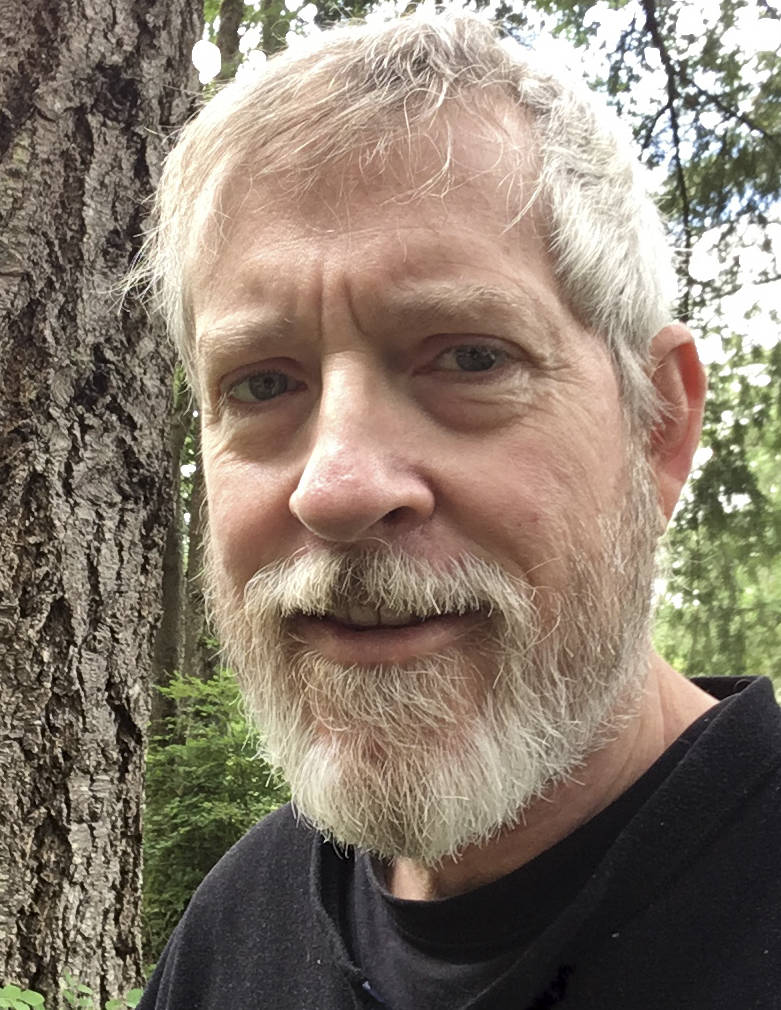March 22, 1992,
Fording the River
By Tom Groenewel
The Sam’s River Trail heads upriver for a mile then splits off toward an old homestead. Back in the day someone cleared a few acres of land to homestead and raise cows and grow fruit trees and a garden. There is no sign of the homestead. An extreme place to subsist.
The old orchard is suffocating in a layer of lichen, plants, moss, slugs and ferns. A small stream I can jump across runs close to the old homestead has just a few gallons a minute flow. The banks are covered in lush growth, pebbles and aquatic plants cover the bottom, the current flows, barely noticed, except for the gentle waving of plants in the current. A few steps upstream the surface tension is broken from a small spring pushing up from the bottom. Water is everywhere in the rainforest.
The trail curves back through the forest, crosses the road and leads down to the banks of the Queets. A beautiful river, running neatly through the main channel, draining the Olympics of perpetual moisture, rain and glacial melt. The river bed is over 60 yards wide, the bed mostly empty, waiting for the next flow.
Walking up the Queets away from the road I notice a blaze mark across the river where the Queets River Trail begins. The Queets River which must be forded to begin the trail. I’m here with no intention to ford the river but we’ll see. Not bad, there is a riffle area a short distance upstream which looks like the easiest way across. The current is strong and the glacial water will be well over my knees. The bottom is filled with shifting cobbles covered in slippery algae. I avoid fording.
I’ve seen bad things happen at fords. Most memorable would be in Utah on a back of beyond dusty sandstone road and there was a sedan. A sedan 20 miles to the nearest paved road, driving all those miles with low clearance and no 4WD? There was a flash flood happening after a quick downpour and the sedan tried to drive across and continue back home. The sedan was swept off the road grade and about ten feet downstream and now pinned against the bank. There is no immediate emergency with just two feet of water.
I pause at the top of the hill overlooking the flood and I see the sedan right away. What to do? Turn around and go back to the Anasazi Ruin I came from? I know what’s gonna happen. The man will be embarrassed to ask for help and the women will be hysterical. They are from the city, somewhere, they are just not there right now, they are here. He will want to know if I can pull his sedan out of the water. No, I can’t pull it out. He will need a tow truck to take it somewhere so the insurance company can determine the car is a total loss.
He starts to tell his story of what happened, the image is clear to see and predictable: He purposely drove into the flashflood. He wants a ride into town, but I’m not going into town. Really, I’m not going back to town. I’m going up a different road heading north to Horse Shoe Canyon. I am not driving an extra 20 miles out plus 20 miles back over the rugged sandstone road. It would take half a day. I give him some extra water and point him in the right direction. A long walk but he’ll make it. Maybe someone else will give him a ride, at least chances are good. If he paces himself and conserves water in the 90-degree heat this afternoon he should be at the main road by midnight. His wife says she will sleep in the car to avoid rattlesnakes. Better hope the flood doesn’t rise. He takes my questionable directions and heads for the main road.
Good luck to him, and her.
To be continued …



